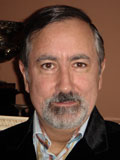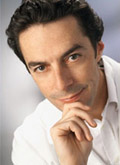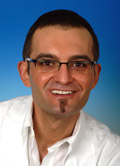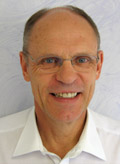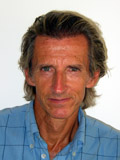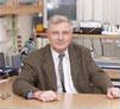News from the XXIII Congress of the ESCRS
Posted on 09/09/2005
At the XXIII Congress of the European Society of Cataract and Refractive Surgeons (ESCRS) in Lisbon, Portugal, Rayner hosted two very well attended Satellite Meetings.
On Friday 9th September 2005, at the aptly named meeting, “We have the Edge – introducing the Rayner Multifocal”, delegates were not only introduced to Rayner’s new multifocal intraocular lens (M-flex®) but were also presented with the results from some new clinical studies for the C-flex® and Superflex® intraocular lenses.
Professor David J. Apple (Salt Lake City, USA) discussed the “Achilles Heel” of so many single-piece injectable IOLs in that their vulnerable haptic / optic junctions allowed for the potential migration of lenticular epithelial cells (LECs), thereby contributing to increased posterior capsular opacification (PCO). He emphasised the benefit of theAmon-Apple Enhanced Square Edge and high IOL biocompatibility in terms of their effect of reducing even further, the incidence of PCO. Professor Apple also spoke about his forthcoming biography of the late Sir Harold Ridley and shared with the audience some recently discovered photographs which will be included in the book.
Mr. Charles Claoué (London, UK) presented “The Rayner Multifocal IOL – a new treatment for presbyopia” during which he discussed the clinical results for the first European implantation of M-flex® which he performed on 31st August, 2005. Mr. Claoué‘s initial impressions were very favourable, most notably, the excellent contrast sensitivity associated with the unique aspheric refractive optic design of the Rayner lens.
Dr. Ramesh Shah (Mumbai, India) presented the “Initial Study of Rayner Multifocal Lenses” and also concluded that Rayner’s M-flex®Multifocal IOL gave results showing very little contrast loss. Dr. Shah also suggested a unilateral implantation advantage with M-flex®and reported a significantly low incidence of halos.
Mr. Ashok Vyas (Scarborough, UK) showed delegates a remarkable series of photographs during his presentation “The Performance of the Enhanced Square Edge of C-flex® and Superflex® at 24 months – a Photo Essay”. Mr. Vyas clearly demonstrated the effect of Rayner’s unique Enhanced Square Edge in terms of restricting the centripetal growth of lenticular epithelial cells when viewed under slit-lamp examination at 24 months post-operatively.
Mr. Vyas’ results were corroborated by Professor Michael Amon (Vienna, Austria) in his presentation “Uveal and Capsular biocompatibility of C-flex®, Superflex® and other hydrophilic acrylics”. Professor Amon’s results, which showed that the “modified optic edge design of the Rayner C-flex® has a better ability to prevent PCO” was well supported, as was his conclusion that the “new generation of hydrophilic IOLs offered a good alternative to the hydrophobics”.
Dr. Günal Kahraman (Vienna, Austria) presented the “C-flex® Study – Vienna site one-year results”, co-authored with Professor Michael Amon and concluded that one year post-implantation, C-flex® showed excellent uveal and capsular biocompatibility.
Dr. Robert Reid (Vanderbijlpark, South Africa) presented on “Artefacts on the posterior surface of the Rayner 570H and 620H encountered during surgery” but concluded that they were not associated with any vision loss, glare or optical aberration. Moreover, he described that they were easily removed and expressed confidence that the imminent launch of the new Rayner Injector would solve the issue.
On Saturday 10th September 2005, Rayner’s enviable position as the manufacturer of one of the world’s foremost toric intraocular lenses was enhanced, as an internationally renowned faculty presented the latest clinical evidence for Rayner’s Toric intraocular lens (T-flex®).
Dr. Lorenzo Artaria (Lugano, Switzerland) delivered his keynote presentation “The Rayner Toric Intraocular Lens for the correction of Corneal Astigmatism in Cataract Surgery”. He demonstrated the implantation of the Rayner Toric IOL to be a “safe and effective method to correct corneal astigmatism in cataract patients” and he concluded by saying that he encouraged the use of this IOL for all corneal astigmatisms greater than one diopter.
Dr. Tanja Rabsilber (Heidelberg, Germany) presented “First Experiences with a New Toric Hydrophilic Acrylic IOL” on behalf of Professor Gerd Auffarth and also presented “Clinical Results of the Rayner Toric IOL 571T” demonstrating their on-going, superb results with Rayner Toric IOLs. They concluded that the Rayner Toric Centerflex® 571T IOL provides excellent results in cataract and refractive surgery with pre-existing astigmatism and that “careful IOL calculation and exact marking and positioning is important”. The “excellent centration and minimal rotation of the Rayner Toric lens” was described as being of paramount importance.
Professor Marek Prost (Warsaw, Poland) presented “Paediatric Implantation of a Rayner Toric IOL” and demonstrated the advantages of the Rayner Toric lens in paediatric surgery, preferring to restrict implantation only to patients aged eight years or older – not because of any inherent problem with the lens but simply because the rapid ocular development of the younger patient could be construed as a contra-indication.
Dr. Andrey Zolotaryov (Samara, The Russian Federation) presented “In Quest of the Ideal IOL” and in accord with the other members of the faculty, he concluded that the advantage of a 360° Square Edge in terms of PCO reduction was unquestionable. He also supported the results of some other international research by concluding that the adhesiveness of the hydrophobic biomaterials offered no significant advantage to low PCO rates and that there was also much less fibrosis and wrinkles associated with the Rayner lensescompared with the hydrophobics. Dr. Zolotaryov also commented on the excellent centration of the Rayner lens and reported no significant difference in Visual Acuity or Nd:YAG capsulotomy rates when compared with hydrophobic lenses.

